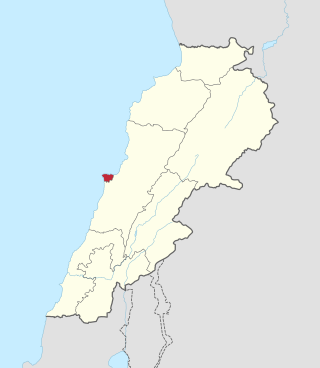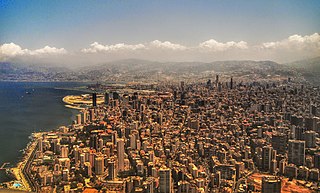Related Research Articles

A car bomb, bus bomb, van bomb, lorry bomb, or truck bomb, also known as a vehicle-borne improvised explosive device (VBIED), is an improvised explosive device designed to be detonated in an automobile or other vehicles.
The Islamic Jihad Organization, was a Lebanese Shia militia known for its activities in the 1980s during the Lebanese Civil War.

Early on a Sunday morning, October 23, 1983, two truck bombs struck buildings in Beirut, Lebanon, housing American and French service members of the Multinational Force in Lebanon (MNF), a military peacekeeping operation during the Lebanese Civil War. The attack killed 307 people: 241 U.S. and 58 French military personnel, six civilians, and two attackers.

Since 2004, a series of bombings and assassinations have struck Lebanon, most of them occurring in and around the capital, Beirut. This wave of bombings began with the assassination attempt on Marwan Hamadeh, then peaked with the assassination of former Prime Minister Rafic Hariri on 14 February 2005, which touched off the Cedar Revolution and the withdrawal of Syrian troops. After the massive protests sparked by Hariri's killing, several more bombings hit Lebanon.

The Multinational Force in Lebanon (MNF) was an international peacekeeping force created in August 1982 following a 1981 U.S.-brokered ceasefire between the Palestine Liberation Organization (PLO) and Israel to end their involvement in the conflict between Lebanon's pro-government and pro-Syrian factions. The ceasefire held until June 3, 1982 when the Abu Nidal Organization attempted to assassinate Shlomo Argov, Israel's ambassador to London. Israel blamed the PLO and three days later invaded Lebanon. West Beirut was besieged for seven weeks before the PLO acceded to a new agreement for their withdrawal. The agreement provided for the deployment of a Multinational Force to assist the Lebanese Armed Forces in evacuating the PLO, Syrian forces and other foreign combatants involved in Lebanon's civil war.

The April 18, 1983, United States embassy bombing was a suicide bombing in Beirut, Lebanon, that killed 32 Lebanese, 17 Americans, and 14 visitors and passers-by. The victims were mostly embassy and CIA staff members, but also included several US soldiers and one US Marine Security Guard. It was the deadliest attack on a US diplomatic mission up to that time, and was considered the beginning of Islamist attacks on US targets.
The Front for the Liberation of Lebanon from Foreigners (FLLF), or Front pour la Libération du Liban des Étrangers (FLLE) in French, was a formerly obscure underground militant organization that surfaced in Lebanon at the early 1980s.
The French Embassy, Beirut is the chief diplomatic mission of France in Lebanon. Its ambassador has been Bruno Foucher since 2017.
The Lebanese–Syrian border clashes were a series of clashes on the Lebanon–Syria border caused by the ongoing Syrian Civil War.
On 9 July 2013 the southern suburb of Beirut, Bir el-Abed was hit by a car bomb. The bombing injured at least 53 people, as it was close to a supermarket which was heavily packed in preparation for Ramadan, but did not claim any lives. The bombing increased fear amongst the Lebanese people that the war in Syria was close to entering Lebanese territory. This bombing took place in the heart of Lebanon's Hezbollah militant group's primary location. This group is a Shia Islamist political party known for supporting, and fighting alongside President Bashar al-Assad in Syria's civil war; leading people to believe that the bombing was intentional, and intending to relay a message to those it targeted.

The Iranian embassy bombing was a double suicide bombing that occurred in front of the Iranian embassy in Beirut, Lebanon on 19 November 2013. The two bombings resulted in 23 deaths and injured at least 160 others.

Terrorism in France refers to the terrorist attacks that have targeted the country and its population during the 20th and 21st centuries. Terrorism, in this case is much related to the country's history, international affairs and political approach. Legislation has been set up by lawmakers to fight terrorism in France.
The following lists some remarkable events that happened in 2014 in Lebanon on a monthly basis.

On 12 November 2015, two suicide bombers detonated explosives in Bourj el-Barajneh, a southern suburb of Beirut, Lebanon, that is inhabited mostly by Shia Muslims. Reports of the number of fatalities concluded that 43 people died directly from the detonation. Islamic State of Iraq and the Levant (ISIL) claimed responsibility for the attacks.
From 1985 to 1986, a series of terrorist attacks in Paris, France were carried out by the Committee for Solidarity With Arab and Middle Eastern Political Prisoners (CSPPA), a previously unknown group, demanding the release of three imprisoned international terrorists. The CSPPA was believed to have been some combination of Palestinians, Armenian nationalists, and Lebanese Marxists, though it was later reported that they were mainly instigated by Hezbollah, sponsored by the Iranian state. The CSPPA demanded the release of Anis Naccache, from the Iranian state network; Georges Ibrahim Abdallah, member of the Lebanese Armed Revolutionary Factions (LARF); and Varadjian Garbidjan, member of the Armenian Secret Army for the Liberation of Armenia (ASALA).

The earliest settlement of Beirut was on an island in the Beirut River, but the channel that separated it from the banks silted up and the island ceased to be. Excavations in the downtown area have unearthed layers of Phoenician, Hellenistic, Roman, Byzantine, Arab, Crusader, and Ottoman remains.
On 22 April 1982, a powerful car bomb detonated on Rue Marbeuf in the 8th arrondissement of Paris in France during the morning rush hour. It killed a young woman and injured 60 other people. The offices of the Lebanese newspaper Al-Watan al-Arabi appeared to be the target.
References
- ↑ "BEIRUT BOMB KILLS 12 AT FRENCH EMBASSY (Published 1982)". The New York Times. 25 May 1982. Archived from the original on 2022-10-22.
- ↑ Lucien George (1982-05-25), "L'attentat a fait onze morts", Le Monde
- ↑ Sitbon, Guy (29 May 1982). "Beyrouth : l'ennemi sans visage". Archived from the original on 29 May 1982.
- ↑ George, Lucien (25 May 1982). "L'attentat a fait onze morts". Le Monde.